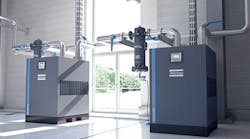Editor's Note: This post was sponsored by Atlas Copco Compressors.
Compressed air systems are some of the most complex assets found in plants, and come with a wide range of responsibilities for maintenance and reliability teams. These can include upgrading the system to accommodate new demand profiles, monitoring power consumption, reducing waste caused by compressed air leakage and water in the lines, and managing any rental compressor units.
Paul Humphreys is VP of Communications and Branding at Atlas Copco Compressors, a global, industrial company based in Stockholm, Sweden whose market-leading compressors, vacuum solutions, generators, pumps, power tools and assembly systems empower customers to grow and drive society forward.
Plant Services recently spoke with Paul on why a compressed air audit is the best first step toward getting a handle on the energy costs associated with your system, and the range of compressed air service and supply options that are opening up to plant teams in the post-COVID era.
Q: For many of our readers, the energy cost associated with their compressed air system is the single largest line on their energy budget. What are the signs that plant teams can watch for that indicate current systems are costing them money, and that it may be time for a technology upgrade?
A: The challenge of looking at an energy bill is that it might have always been the same. It’s accepted as the cost, and the cost has been built into your budget for years.
I think compressed air is the ultimate caveat for the phrase: — “if it’s not broken, then don’t fix it.” Atlas Copco has a straightforward rule when we are working with our customers on capital expenditure purchases — if the equipment does not provide you with a clear payback that fits your business, then don’t purchase!
Simple air studies have never been easier to benchmark and understand savings, but here are five things that might indicate it’s time to look at your system.
- You see the manufacturer’s compressor service team more often than your dentist.
- You feel like you need to wipe your feet when leaving the compressor room.
- You need to shout if chatting to a colleague when standing near your compressor.
- You can’t monitor your compressor system unless you’re standing next to it (i.e., no remote access).
- You are not able to view simple energy output graphs for the performance of your compressor.
Q: On-site air audits have also helped plant teams handle compressed air system operations, but remote air audits are gaining traction. Can you tell us how those work?
A: You could say there are two types of audits (and then many sub-types), but the two basic things to audit are system efficiency and quality, and air quality.
When we talk about audits, detailed supply, and demand-side audits always need to be conducted on-site. The term audit is also often used for more straightforward studies that involve data-logging machines and monitoring performance over a defined period — we refer to these more as surveys than audits. The simple installation means that the equipment needed for a survey can be sent to the customer without the need for somebody to go on-site and set it up. Then the hardware is returned, and the data is put into our modeling system to produce graphs and see where savings can be made. This can all be done remotely if that’s the customer’s choice.
Air quality testing is something which, rightly so, continues to gain significance and is even mandated inside critical industries like food and beverage. This will always involve gaining an air sample on-site while making sure not to contaminate the sample before it is sent away for testing.
As highlighted above, all new compressors can easily be remotely connected when it comes to monitoring efficiency. So, you can always see the performance and plot analysis curves, no matter where you are in the world. You can think of remote monitoring as an ongoing audit that happens 24/7, and importantly, any potential issues are identified before they can become serious problems.
Q: What alternate models exist for buying compressed air, beyond standard options to own, lease, or rent the compressors themselves?
A: It’s not such a new trend, but as compressed air has always been talked about as the “fourth utility” inside a plant, more customers are considering purchasing air like they do gas, electricity, or water. So, in essence, buying air and not the actual compressors.
For the right customer, this has several advantages, including not needing a significant capital expenditure at the start of the project and having no maintenance responsibility for the equipment, as that’s taken care of by the manufacturer.
From a supplier point of view, it’s all about offering the customer multiple ways to buy, understanding their business needs, and matching the best program to those needs. The cost of capital is still relatively low at present, and so for many companies, this does represent a good time to make any upgrades needed.
Q: Given the state of the economy as we all move out of the COVID crisis moment, what advice would you give to plant teams who want to build out and/or optimize their compressed air systems?
A: We think compressed air systems must be built with flexibility top of mind. Two critical considerations for plants when selecting compressed air systems are:
- What happens if our production needs change? (This could be an increase or decrease in demand.)
- What would happen if my compressor was offline?
When it comes to flexibility for demand, variable speed drive compressors are not a new technology, but many customers who could utilize them still have not. A simple way to explain variable speed drive would be to think of these compressors like multiple compressors inside one box. They give you the ability to run efficiently based on different demand loads.
Another big part of flexibility is, how is your system set up? Every plant manager across the country knows the cost of downtime, so it’s possible to build a system in a way that means it’s not all or nothing — adding a second compressor or running two smaller ones instead of one large one, for example, has never been easier.
The pandemic has also shown us how the supply chain can be affected quite quickly, from the manufacturing of goods to the ability of shipping companies to deliver based on capacity issues. This means that manufacturers cannot afford to ignore contingency planning for all scenarios.
And one last thing: never neglect service and the need for preventative maintenance — it will catch up with you eventually.
This story originally appeared in the August 2021 issue of Plant Services. Subscribe to Plant Services here.

